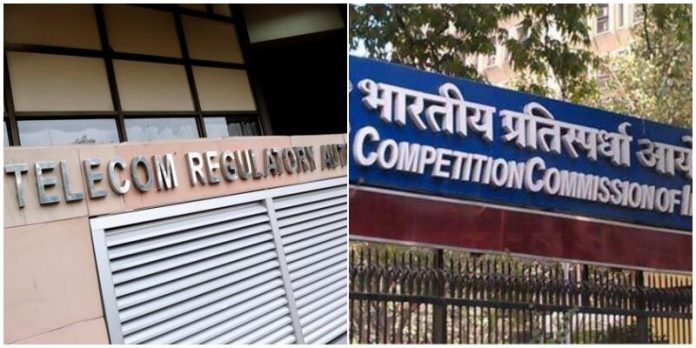This article is written by Chandana, from The Tamil Nadu Dr. Ambedkar Law University (SOEL). This is an article which deals with the interplay of roles of Competition Commission of India and the Telecom Regulatory Authority of India.
Table of Contents
Introduction
Sectoral Regulations and Competition Commission have a similar goal that is to safeguard the consumer’s interest. But they are governed by the different procedures as given to them under different statutes. The prime difference is the Competition law that helps in curbing the anti-competitive practices in the market while the Sectoral regulators aim at promoting competition by ushering to structural changes. Such a difference of perspective in the two regulators always results in a conflict of decision. Such an outcome may not only result in market uncertainty but also in increasing their exposures to potential liability. This inevitably leads to the creation of duplication of efforts, inefficient use of resources and there might result in an increased risk of forum shopping.
Competition Commission of India (CCI)
The Competition Commission of India was established by the Central Government under Competition Act, 2002 for the purposes of administering, implementing and enforcing the act and it was duly constituted in March 2009.
Establishment of Competition Commission of India
As per Section 7 of Competition Act, 2002:
- The Competition Commission of India is constituted by the Central Government.
- The powers of corporate personality are conferred on the commission.
Appointment of Chairperson and Members
As per Section 8(1) of Competition Act, 2002:
- The Commission shall be headed by Chairperson and the commission shall consist of not more than six members.
- The appointment of chairperson and the members shall be made by the Central government for the first tenure of their appointment and thereafter their appointment shall be tendered as per the rules.
Term of office of Chairperson and Members
As per Section 10(1) of Competition Act, 2002:
- The chairperson and the members can hold office for the period of five years from the date of appointment.
- They are also eligible for re-appointment.
Duties of Commission
As per Section 18 of Competition Act, 2002:
The following are duties of the commission which he is liable to discharge:
- to prevent the practices which have adverse effects on competition.
- to promote and sustain competition in the market.
- to protect the interest of the consumers.
- to ensure there is freedom of trade and the absence of monopoly.
Establishment of Appellate Tribunal
As per Section 53-A of Competition Act, 2002:
The Central government establishes an appellate tribunal known as Competition Appellate Tribunal to hear and dispose of appeals against any issues or directions passed by the commission.
Telecom Regulatory Authority Of India (TRAI)
Objective of TRAI
Important objectives of TRAI is to:
- To provide a fair and transparent policy environment.
- To promote fair competition.
Establishment of TRAI
As per Section 3 Telecom Regulatory Authority of India Act, 1997:
- The Telecom Regulatory Authority of India was established by the central government under the Telecom Regulatory Authority of India Act, 1997.
- TRAI was established for the purposes of regulating the telecom sectors including the fixation or revision of tariffs for telecom services.
Appointment of Chairperson and other members
As per Section 5 of Telecom Regulatory Authority of India Act, 1997:
- TRAI shall be presided by the Chairperson, two whole-time members and two part-time members,
- They shall hold office for a term not more than three years.
Functions of TRAI
As per Section 11 of Telecom Regulatory Authority of India Act, 1997:
- can make recommendations either on the suo motu or on the request from the licensor on the following matters:
- the need and timing for the introduction of a new service provider.
- terms and conditions of the licence to a service provider.
- the authority to revoke the license if there is non-compliance of terms and conditions of license.
- if there are any technological improvements in services provided by the service providers.
- the authority shall discharge the following functions:
- ensure compliance of terms and conditions of the license.
- ensure the technical compatibility.
Establishment of Appellate Tribunal
As per Section 14 of Telecom Regulatory Authority of India Act, 1997:
- The central government shall establish an appellate tribunal called Telecom Dispute Settlement and Appellate Tribunal.
- This tribunal shall resolve the dispute between the:
- Licensor and licensee.
- two or more service providers.
- service provider and a group of consumers.
Sectoral regulators and overlapping of jurisdiction between CCI and different regulators
Sectoral regulators
Before the establishment of sectoral regulators activities such as entry, price, location, telecommunication services, oil exploration and so on were regulated only by the government-owned companies. There was an absolute monopoly in the industry. With the introduction of economic reforms in 1991, there was dire need to establish sectoral regulators, and this led to setting up sectoral regulators. To name few sectoral regulators:
|
Sectoral Regulators |
Year |
Overlapping of jurisdiction between CCI and different regulators
- As per Section 11(1)(iv) of Telecom Regulatory Authority of India Act, 1997 asserts that it can facilitate competition and promote efficiency in the operation of telecommunication services to facilitate the growth in such services. The Competition Act, 2002 has a similar objective and there arises overlap of jurisdiction.
- Insurance Regulatory and Development Authority(Scheme of Amalgamation and Transfer of General Insurance Business) Regulation, 2011 which gives the authority to IRDA to regulate combinations in the insurance sector which is overlapping with the jurisdiction of CCI.
Interplay of the roles of CCI and TRAI
The role of CCI and TRAI is given below in the tabular format-
|
Sectoral Regulatory |
Competition Commission |
|
The sectoral regulatory informs the businesses what to do and how to price the products. |
The competition authority the business what not to do. |
|
The sectoral regulatory usually focuses on the specific secretary of the economy. |
On the other hand, the competition authority focuses on the entire economy. |
|
The sectoral regulatory is ex-ante that means it addresses the behavioural issues even before the problem arises. |
The competition authority is an ex-posto that means it addresses the behavioural issues only after the problem arises except in the case of mergers. |
|
The sectoral regulatory mainly focus on the orderly development of a sector which ensures consumer welfare. |
The competition authority ensures consumers welfare by preventing the unfair transfer of wealth. |
To understand the interplay of the roles between the CCI and TRAI lets us begin by examining the preamble of both the Acts for better understanding.
The Preamble of Competition Commission of India as per the Competition Act, 2002 is “to promote and sustain the competition in the market of India”.
The Preamble of Telecom Regulatory Authority of India Act, 1997 is “to promote and ensure orderly growth of the telecom sector”. As CCI and TRAI share the same objective they differ in their mandate and approach. The differences lead to conflicts of jurisdiction between both the acts. The Supreme court resolved the jurisdiction between CCI and TRAI in Competition Commission of India v. Bharti Airtel Limited and Ors. (2018).
Judicial pronouncement relating to CCI and TRAI
- An application was filed by Reliance Jio Infocomm Limited under Section 19(1) of the Competition Act, 2002 to Competition Commission.
- Section 19(1) Competition Act, 2002 states in case if any enterprise or association of person enters into any agreement which results in causing the adverse effect on competition the competition commissions may enquire into such matters. Reliance alleged that the Bharti Airtel, Idea Cellular Limited and Vodafone India Limited (IDO’s) were abusing their dominant position as per Section 3 of Competition Act, 2002 and Cartelisation as per Section 4 of Competition Act, 2002.
- And these companies were supported by the Cellular Operators Association of India for colluding with those companies and denying the access of sufficient number of Points of Interconnection (POL) to Jio. CCI found that there was a prima facie case of cartelisation IDO’s and COAI. Further CCI authorised the Director-General to carry out the investigation and DG issued notices to IDO’s and COAI.
- A writ petition was filed before the Bombay High Court by the IDO’s and COAI to quash the orders of CCI and to stop DG from further investigation on the grounds that CCI did not have the jurisdiction to decide the case and as TRAI was already seized of the matter.
- The CCI later appealed the issue to the Supreme Court.
Issues
- Whether CCI has jurisdiction to decide the case, considering the points of interconnection is a technical issue?
- Whether the writ petition filed by the IDO’s and COAI is maintainable?
Judgment
- The Bombay High Court set aside the order found up CCI and Supreme court upheld the order of Bombay High Court and also recognised that TRAI is the sector-specific regulator and it has the expertise to deal with the issues arising from the telecom sector and in which CCI has no jurisdiction in matters of telecom sectors.
- After necessary findings, if TRAI comes to the conclusion that within the domain there are anti-competitive practices, then CCI can come into the picture to enforce its decisions as per the relevant provision under the Competition Act, 2002.
- If at all TRAI takes any action which is supposed to be taken by CCI then the TRAI power would be limited to the applicability of Telecom Regulatory Authority of India Act, 1997.
- And thus the jurisdiction of CCI is not completely barred it is only pushed at the later stage. By clearly setting out the powers of both the authorities have a balance between their powers.
- The Supreme court said that TRAI has three important functions as per the Telecom Regulatory Authority of India Act, 1997 and they are:
- TRAI has to resolve various disputes which may arise between the service providers.
- TRAI has to ensure the technical compatibility and regulating relationship between the providers.
- TRAI has to ensure the license conditions are complied by the service providers.
Analysis of the following case
- If any matter comes before the authorities on the question of the telecommunication industry, TRAI will be given the preference to decide the issue and then CCI will follow on.
- Before coming to the final determination on the jurisdiction issue TRAI has to get CCI opinion.
Position between CCI and sectoral regulators from an International perspective
- In Australia, the competition authority adopts industry-specific regulators.
- In the European Union, certain sub-sectors of telecom sectors are out of the purview of regulators.
- In Finland, the competition authorities have signed a Memorandum of Understanding with telecom regulators defining ways to eliminate overlaps of jurisdiction.
- In France, before taking any important decisions there is mandatory consultation between the telecom sector and competition authority.
- In the UK the office of fair trading and the sectoral regulators have concurrent jurisdiction with a common appellate tribunal.
- The jurisdiction of the competition authorities and sectoral regulators are blurred in countries like Sri Lanka, Botswana, Kenya, Pakistan and India. The conflicts are left to be resolved by courts.
Conclusion
The interplay between the Competition Commission and the Telecom Regulatory Authority is a crucial one. There must be formal coordination between the CCI and TRAI otherwise there are high chances of overlap of jurisdictions. From the above analysis, we can come to the conclusion that TRAI has domain expertise in relevant sectors whereas CCI deals with competition only within the limits of provision as given under Competition Act, 2002. We have also found that various countries in the world have overlapping jurisdictions between the competition authority and the sectoral regulators. Countries follow either exclusive jurisdiction, cooperative jurisdiction or the concurrent jurisdiction. Countries like India have to adopt a Memorandum of Understanding like Finland to avoid overlapping of jurisdictions.
References
- https://www.cci.gov.in/sites/default/files/presentation_document/11lahore_25_26march06_20080410175442.pdf
- https://indiacorplaw.in/2019/01/supreme-court-jurisdictional-conflicts-cci-trai.html
- https://competitionlawobserver.wordpress.com/2017/06/11/cci-and-sectoral-regulators/
- https://www.cci.gov.in/sites/default/files/cci_pdf/competitionact2012.pdf
- http://ijlt.in/wp-content/uploads/2015/09/TRAI-Act-1997.pdf
LawSikho has created a telegram group for exchanging legal knowledge, referrals and various opportunities. You can click on this link and join:












